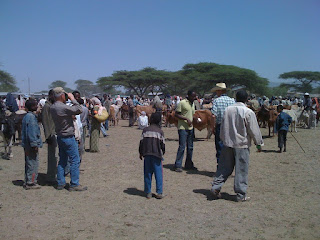Bulbula Market and Embryo Flushing
Today Abera, Haven, Mark and I visited an Ethiopian livestock market to learn how the animals are sold and to see the condition of the local animals. We drove north for almost an hour to the town of Bulbula, where they were holding the market.
They have a large cleared area where everyone congregates with their animals. Donkeys, cattle, sheep and goats are each in a different part of the market. The owners all stand there with their animals until the buyers come along. They haggle over prices, and then if the animal is purchased, it is moved to the far side of the market and kept there until the buyer is ready to leave with his newly-purchased animals. Most of the cattle for sale are the oxen, which are males five years old or older, and there were some weaned calves also. The oxen sell for between 2000 and 4000 ETB ($180 to $360). The sheep and goats cost around 200 to 300 ETB (~$25).
Most of the animals are not in the best condition, and really need some good feed and a round of vaccines and insecticides to be marketable by the kinds of standards I am used to. We were quite a spectacle walking around the market, being white Americans, so we drew a crowd everywhere we went. [*Note from Erika: I guess Lonny's learning what movie stars feel like, because he often has people staring and following him around wherever he goes!]
Around noon, we arrived at the Adami Tulu Animal Research Center (ATARC) for the embryo recovery training. Abera and Tadesa, our driver, went to the cafeteria for lunch while Haven, Mark and I snacked on jerky and almonds. The Adami Tulu staff and the team from Debre Zeyit started arriving at 1:00pm. By 1:30, we had a total participant count of 26 people, and our training was underway.
I spent the first hour and a half discussing the theory of embryo transfer and how it fits in with other management practices. I focused on the need for the trained staff to teach the local farmers to use good animal management practices to increase their production. I stressed that improving the genetic potential of the animals would not do any good unless the farming practices changed to capitalize on that improvement. For instance, Ethiopian farmers could easily double their milk production by providing more clean drinking water to their cows and feeding them a more nutritious diet.
After the discussion, we headed out to the corrals to do the embryo flushing (this is the retrieval of the embryos from the cows using a fluid solution). We had two participating donor cows. The first donor did not respond to the FSH (follicle stimulating hormone) treatment, so we skipped her. The second cow over-stimulated, responding too well to the treatment. The boran cattle are much more difficult than Holsteins to retrieve embryos from, and this cow was a classic example. I was finally able to finish with her. I had some difficulty threading the catheter, but the balloon placement went well, so I was fairly confident that we would have some embryos to look at.
After the flush, we went into the laboratory to search for the embryos. They had a couple of microscopes set up, but they were different than what I have used in the past. It took me a while to get them focused. I searched through the dish a couple of times, but did not immediately find anything. The lab was packed with people trying to see what was going on, which made it difficult to work, since there were so many people hanging over my shoulders (see picture below).
I moved some of the fluid to a new Petri dish so that I could do a better job searching. By this time most everyone had to leave on their bus, and I was beginning to worry that we would not find anything, which could put a damper on our efforts at this facility, and possibly cause the staff to lose excitement for the technology. I decided to search one more time and prayed fervently that I would be able to find something. I was ecstatic when I found a beautiful morula!
[*Note from Erika: A morula (Latin for mulberry) is an embryo at an early stage of embryonic development, consisting of cells called blastomeres in a solid, round ball.]
Relief flooded over me, as I recognized that my prayer had been answered. This was yet another one of those little tender mercies that the Lord continues to pour out upon this project. It is not always easy, and I struggle sometimes, feeling overwhelmed and stressed about the enormity of the task before us, but with lots of prayer and pleading, I am able to make it through, and the Lord always steps in and makes up for my personal shortcomings.
Dr. Tesfaye had stayed there with us when everyone else had left, so he was able to see the embryo. In the U.S., I would have probably been disappointed to only get one embryo, but considering all of the circumstances and conditions, I was thrilled. I carefully cooled the embryo off to preserve it for tomorrow's embryo transfer training.
On our way home we stopped at the Sabana Resort. I was very tired, but knew that it would be the only chance that Haven and Mark would have to see it. The meal was good, and we followed it up with ice cream. It was a great way to celebrate our success, and it gave us a chance to talk about our projects. I really appreciate having both of them to help me. This is such an amazing opportunity. Sometimes I feel like I need to pinch myself to check and see if all of this is really happening to me.


Whew! Thank Heavens for that one! (literally!) Good job, Lonny!
ReplyDelete